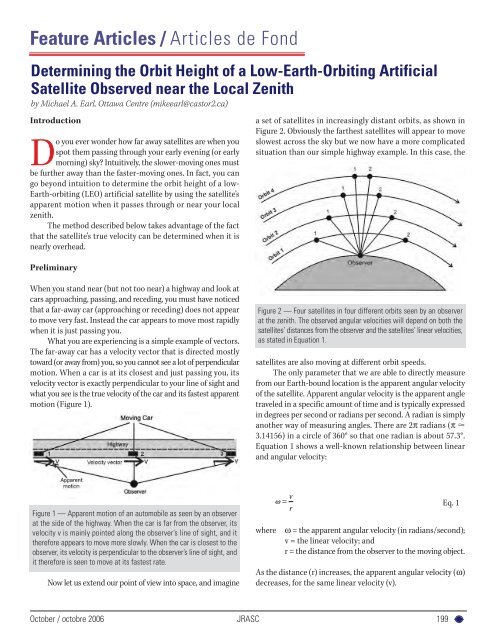I N S I D E T H I S I S S U E
insidethisissue - The Royal Astronomical Society of Canada
insidethisissue - The Royal Astronomical Society of Canada
Create successful ePaper yourself
Turn your PDF publications into a flip-book with our unique Google optimized e-Paper software.
Feature Articles / Articles de FondDetermining the Orbit Height of a Low-Earth-Orbiting ArtificialSatellite Observed near the Local Zenithby Michael A. Earl, Ottawa Centre (mikeearl@castor2.ca)IntroductionDo you ever wonder how far away satellites are when youspot them passing through your early evening (or earlymorning) sky? Intuitively, the slower-moving ones mustbe further away than the faster-moving ones. In fact, you cango beyond intuition to determine the orbit height of a low-Earth-orbiting (LEO) artificial satellite by using the satellite’sapparent motion when it passes through or near your localzenith.The method described below takes advantage of the factthat the satellite’s true velocity can be determined when it isnearly overhead.Preliminarya set of satellites in increasingly distant orbits, as shown inFigure 2. Obviously the farthest satellites will appear to moveslowest across the sky but we now have a more complicatedsituation than our simple highway example. In this case, theWhen you stand near (but not too near) a highway and look atcars approaching, passing, and receding, you must have noticedthat a far-away car (approaching or receding) does not appearto move very fast. Instead the car appears to move most rapidlywhen it is just passing you.What you are experiencing is a simple example of vectors.The far-away car has a velocity vector that is directed mostlytoward (or away from) you, so you cannot see a lot of perpendicularmotion. When a car is at its closest and just passing you, itsvelocity vector is exactly perpendicular to your line of sight andwhat you see is the true velocity of the car and its fastest apparentmotion (Figure 1).Figure 2 — Four satellites in four different orbits seen by an observerat the zenith. The observed angular velocities will depend on both thesatellites’ distances from the observer and the satellites’ linear velocities,as stated in Equation 1.satellites are also moving at different orbit speeds.The only parameter that we are able to directly measurefrom our Earth-bound location is the apparent angular velocityof the satellite. Apparent angular velocity is the apparent angletraveled in a specific amount of time and is typically expressedin degrees per second or radians per second. A radian is simplyanother way of measuring angles. There are 2π radians (π 3.14156) in a circle of 360° so that one radian is about 57.3°.Equation 1 shows a well-known relationship between linearand angular velocity:Figure 1 — Apparent motion of an automobile as seen by an observerat the side of the highway. When the car is far from the observer, itsvelocity v is mainly pointed along the observer’s line of sight, and ittherefore appears to move more slowly. When the car is closest to theobserver, its velocity is perpendicular to the observer’s line of sight, andit therefore is seen to move at its fastest rate.Now let us extend our point of view into space, and imaginewhere = v rEq. 1ω = the apparent angular velocity (in radians/second);v = the linear velocity; andr = the distance from the observer to the moving object.As the distance (r) increases, the apparent angular velocity (ω)decreases, for the same linear velocity (v).October / octobre 2006 JRASC199
















